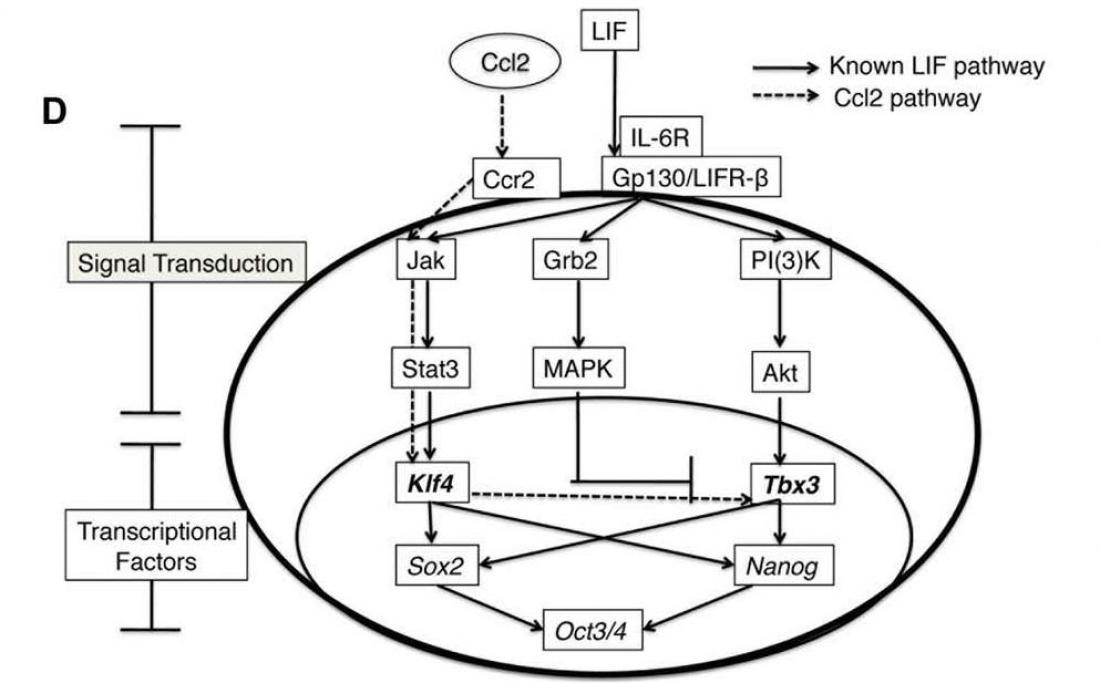Diagram of the Ccl2 and leukemia inhibitory factor (LIF) signal pathways integrating into the transcription network. Known LIF signal pathway is shown with black arrow. Our finding of Ccl2 signal pathway for promoting pluripotency is shown as dot black arrow. Abbreviations: IL-6R, interleukin–6 receptor; LIF, leukemia inhibitory factor; LIFR, leukemia inhibitory factor receptor; NC, negative control; PI(3)K, phosphoinositide 3-kinase.
A protein that helps maintain mouse stem cell pluripotency has been identified by researchers at the RIKEN Omics Science Center. The finding, published in the August issue of Stem Cells (first published online July 26, 2011), points the way to advances in regenerative medicine and more effective culturing techniques for human pluripotent stem cells.
Through their capacity to differentiate into any other type of cell, embryonic stem cells (ES cells) and induced-pluripotent stem cells (iPS cells) promise a new era of cell-based treatments for a wide range of conditions and diseases. Cultivating such cells, however, commonly relies on the use of so-called “feeder” cells to maintain pluripotency in cell culture conditions. Feeder cells keep stem cells in their undifferentiated state by releasing nutrients into the culture medium, but they have the potential to introduce contamination which, in humans, can lead to serious health risks.
Previous research has shown that mouse pluripotent stem cells can be cultured without feeder cells through the addition of a cytokine called Leukemia Inhibitory Factor (LIF) to the culture media (“feeder-free” culture). LIF is secreted by mouse feeder cells and activates signal pathways reinforcing a stem cell regulatory network. The researchers discovered early in their investigation, however, that the amount of LIF secreted from feeder cells is much less than the amount needed to maintain pluripotency in feeder-free conditions. This points to other, as-of-yet unknown contributing factors.
To clarify these factors, the research group analyzed differences in gene expression between mouse iPS cells cultured on feeder cells and those cultured in feeder-free (LIF treated) conditions. Their results revealed 17 genes whose expression level is higher in feeder conditions. To test for possible effects on pluripotency, they then selected 7 chemokines (small proteins secreted by cells) from among these candidates and overexpressed them in iPS cells grown in feeder-free conditions. They found that one chemokine in particular, CC chemokine ligand 2 (CCL2), enhances the expression of key pluripotent genes via activation of a well-known signal pathway known as Jak/Stat3.
While CCL2 is known for its role in recruiting certain cells to sites of infection or inflammation, the current research is the first to demonstrate that it also helps maintain iPS cell pluripotency. The findings also offer broader insights applicable to the cultivation of human iPS/ES cells, setting the groundwork for advances in regenerative medicine.
For more information, please contact:
Harukazu Suzuki
LSA Technology Development Unit
RIKEN Omics Science Center
Tel: +81-(0)45-503-9222 / Fax: +81-(0)45-503-9216
Yokohama Planning Section
RIKEN Yokohama Research Promotion Division
Tel: +81-(0)45-503-9117 / Fax: +81-(0)45-503-9113
Global Relations Office
RIKEN
Tel: +81-(0)48-462-1225 / Fax: +81-(0)48-463-3687
Email: [email protected]
Reach us on Twitter: @rikenresearch
Reference
Yuki Hasegawa, Naoko Takahashi, Alistair R. R. Forrest, Jay W. Shin, Yohei Kinoshita, Harukazu Suzuki and Yoshihide Hayashizaki. "CC Chemokine Ligand 2 and Leukemia Inhibitory Factor Cooperatively Promote Pluripotency in Mouse Induced Pluripotent Cells." Stem Cells, 2011, DOI: 10.1002/stem.673
About RIKEN
RIKEN is Japan’s flagship research institute devoted to basic and applied research. Over 2500 papers by RIKEN researchers are published every year in reputable scientific and technical journals, covering topics ranging across a broad spectrum of disciplines including physics, chemistry, biology, medical science and engineering. RIKEN’s advanced research environment and strong emphasis on interdisciplinary collaboration has earned itself an unparalleled reputation for scientific excellence in Japan and around the world.
About the Omics Science Center
Omics is the comprehensive study of molecules in living organisms. The complete sequencing of genomes (the complete set of genes in an organism) has enabled rapid developments in the collection and analysis of various types of comprehensive molecular data such as transcriptomes (the complete set of gene expression data) and proteomes (the complete set of intracellular proteins). Fundamental omics research aims to link these omics data to molecular networks and pathways in order to advance the understanding of biological phenomena as systems at the molecular level.
Here at the RIKEN Omics Science Center, we are developing a versatile analysis system, called the “Life Science Accelerator (LSA)”, with the objective of advancing omics research. LSA is a multi-purpose, large-scale analysis system that rapidly analyzes molecular networks. It collects various genome-wide data at high throughput from cells and other biological materials, comprehensively analyzes experimental data, and thereby aims to elucidate the molecular networks of the sample. The term “accelerator” was chosen to emphasize the strong supporting role that this system will play in supporting and accelerating life science research worldwide.



